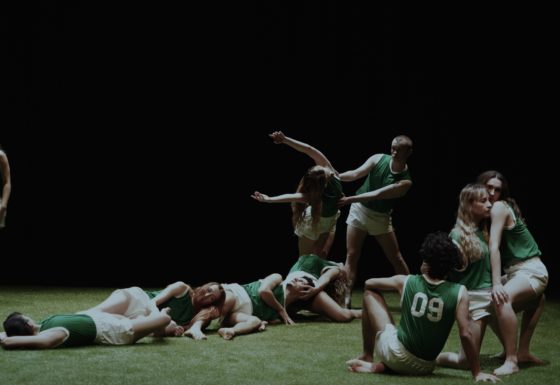Twenty-seven perspectives
Chorégraphie: Maud Le Pladec
Lumière: Eric Soyer
Pièce créée en 2018 lors du Festival Montperllier Danse
Choreography: Maud Le Pladec
Lighting: Eric Soyer
Created in 2018 for the Festival Montperl
En s’emparant de la Symphonie inachevée de Schubert, Maud Le Pladec s’attelle à rendre visible l’invisible, à recomposer la partition, à orchestrer des variations musicales pour tenter d’achever ce chef-d’œuvre.
Twenty Seven Perspectives tire son titre d’un des premiers chantiers, 27 esquisses perceptives, de l’artiste Rémy Zaugg (1943-2005), également historien, théoricien et critique d’art. Zaugg a une obsession : décortiquer le voir. Enquêter inlassablement sur l’acte perceptif. Son premier chantier consiste à analyser une seule et même toile de Cézanne, La Maison du pendu (1873, Musée d’Orsay) et de noter ce qu’il y voit à travers 27 esquisses perceptives. Une opération qui durera cinq ans (1963-1968), témoignant de l’inépuisable réservoir du visible.
À l’instar de l’artiste Zaugg, Twenty Seven Perspectives propose de rendre visible l’invisible. Cette pièce chorégraphique travaille à partir d’une disparition : celle d’une oeuvre musicale majeure (classique) et support de création pour la danse. La ligne de force de la pièce repose sur un concept d’écriture bien particulier : l’œuvre musicale d’où émanent les règles de composition du mouvement, pour ne pas dire qui compose la danse, ne sera jamais révélée dans son originalité au plateau. Méthodiquement, objectivement, il s’agira d’analyser et de décortiquer cette musique de référence pour en dégager les déclinaisons, les perceptions, les variations chorégraphiques. Comme Zaugg l’a fait pour Cézanne, Twenty Seven Perspectives propose une méditation chorégraphique autour du chiffre 27, telles 27 mises en perspective d’une musique à travers les corps et l’espace. Pour ce faire, Maud Le Pladec n’hésite pas à réinventer sa propre écriture chorégraphique en une version volontairement épurée. Une symphonie chorégraphique à la construction mira (regarde ! en espagnol) -culeuse, qui fait entendre la musique et voir la danse autrement.
Taking on Schubert’s Unfinished Symphony, Maud Le Pladec sets about making the invisible visible, recomposing the score and orchestrating musical variations in an attempt to complete this masterpiece.
Twenty Seven Perspectives takes its title from one of the first works , 27 esquisses perceptives, by the artist Rémy Zaugg (1943-2005), also an art historian, theorist and critic. Zaugg’s obsession is to dissect what we see. To tirelessly investigate the act of perception. His first project was to analyze a single painting by Cézanne, La Maison du pendu (1873, Musée d’Orsay), noting what he saw through 27 perceptual sketches. This operation lasted five years (1963-1968), testifying to the inexhaustible reservoir of the visible.
Like the artist Zaugg, Twenty Seven Perspectives proposes to make the invisible visible. This choreographic work is based on a disappearance: that of a major musical work (classical) and the creative base for the dance. The main thrust of the piece is based on a very specific composition concept: the musical work from which the rules of movement composition are derived, which in fact choreographs the dancing, will never be truly revealed on stage. Methodically, objectively, the aim is to analyze and dissect this reference to the music, in order to identify its choreographic variations and perceptions. As Zaugg did with Cézanne, Twenty Seven Perspectives proposes a choreographic meditation around the number 27, such 27 perspectives of a music through bodies and space. To achieve this, Maud Le Pladec does not hesitate to reinvent her own choreographic writing in a deliberately pared-down version. A choreographic symphony with a mira (look! in Spanish)-culous construction that makes you hear the music and see the dance differently.
« Le temps s’étire sur cette symphonie distordue de manière grandiose, et Le Pladec réussit de plus en plus à créer la surprise, dans les solos comme dans les élans du groupe. »
26/01/2019 TELERAMA – E.B.
« Time stretches out on this grandly distorted symphony, and Le Pladec succeeds more and more in creating surprise, in the solos as well as in the surges of the group. »
26/01/2019 TELERAMA – E.B.






